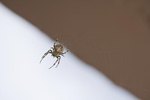
There are about 40,000 different known species of spider, and their breeding habits aren’t all the same. Some mating rituals end in violence, while others end with the male and female simply going their separate ways. Even the ways that spiders court each other differ from species to species, demonstrating that not all types of spider act alike, even when procreating.
Finding a Mate
Before spiders can breed, they must find mates, and the way that they do it depends on the species. For example, male and female jumping spiders develop glowing patches on their bodies as they mature, which they use to identify potential mates. Some species are competitive. Male redback spiders, for example, may fight over the right to mate with a particular female.
Palps and Copulation
The way that a male spider inseminates a female also depends on the species. In some cases, the two don’t actually engage in a traditional sex act at all. While some species, like the Physoculus globusus, engage in traditional genital penetration for insemination, others, like the orb-web spider, can break off their sex organs, or palps, and leave them behind in the females. With the palp blocking the female’s sex organ, she is hindered from mating with other males, increasing the first male’s chances of inseminating her.
Cannibalism
While it’s a myth that all female spiders cannibalize the males after mating, certain species do. The black widow, for example, takes its name from its habit of devouring the male after copulating. In one species of orb-web spider, Argiope bruennichi, the female actually starts cannibalizing the male while they mate. Though he is being eaten as he mates, the male continues the mating ritual so that he can inseminate the female. Because of this determination, about 70 percent of males don’t survive their first mating.
Hatching the Eggs
After the mating ritual is complete, a female spider deposits her eggs in a cocoon until they hatch. When they do, the mother’s reaction varies depending on the spider. For example, the Phyrynus marginemaculatus is nurturing, and stays in close physical contact with her young. A spider who is starving, however, may cannibalize her young to ensure her own survival.
References
Photo Credits
-
Photos.com/Photos.com/Getty Images
Writer Bio
Tom Ryan is a freelance writer, editor and English tutor. He graduated from the University of Pittsburgh with a degree in English writing, and has also worked as an arts and entertainment reporter with "The Pitt News" and a public relations and advertising copywriter with the Carnegie Library of Pittsburgh.


